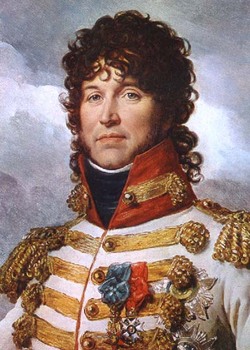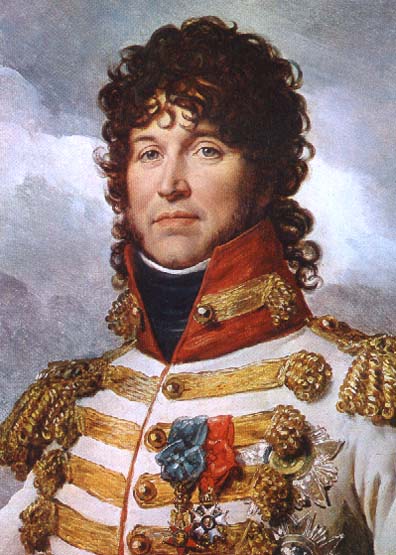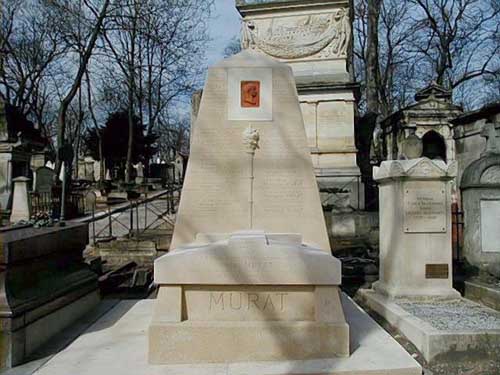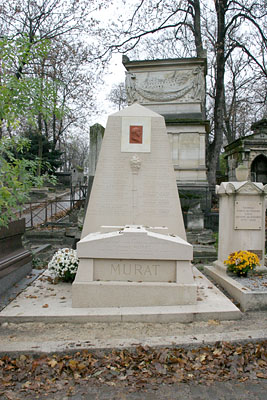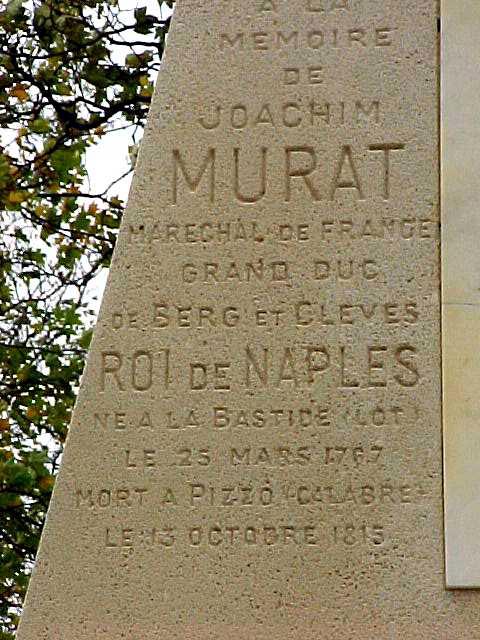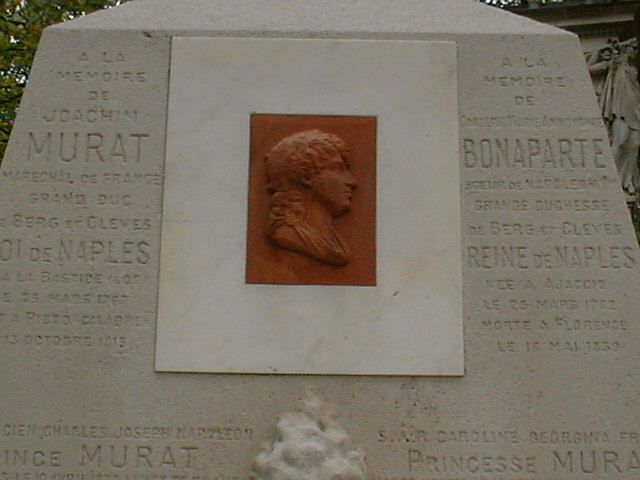Marshal of France, Grand Duke of Berg and Cleves, and King of Naples and Sicily. These titles were bestowed upon him in part by being the brother-in-law of Napoleon Bonaparte, through marriage to Napoleon's youngest sister. He was known as a daring and charismatic cavalry officer and flamboyant dresser, sometimes referred to as "the Dandy King." He was born at Labastide-Fortuniere (now Labastide-Murat), in Lot, France the son of an affluent farmer and innkeeper. His parents encouraged him to become a priest and was taught by his parish priest at the age of 10 he was accepted at the College of Saint Michel in Cahors, France. He entered the seminary of the Lazarists at Toulouse, France, but ran away in 1787 when a regiment of cavalry passed through the city, prompting him to enlist in the Chasseurs de Champagne, also known as the 12th Chasseurs. In 1789 he was forced to resign due to an affair and he returned to his home and became a clerk to a haberdasher (one who sells small items for sewing purposes) at Saint-Cere, France. Shortly afterward he joined the National Guard and managed to be reinstated with the 12th Chasseurs and was promoted to the rank of sous-lieutenant by November 1792. Over the next three years, after the overthrow of French King Louis XVI, civil unrest prevailed in Paris, France, culminating with an armed uprising in the autumn of 1795. On October 3rd of that year General Napoleon Bonaparte, who was the commander of the French National Convention's defending forces, ordered Murat to secure artillery located outside the control of the government's forces and bring them to the center of Paris to defend the members of the National Convention from rioters, which he did the following day without incident. For this effort he was made a chef de brigade (or colonel) and became one of Napoleon's best officers. In 1796 he traveled with Napoleon to northern Italy, first as his aide-de-camp and later as commander of the French cavalry as they fought the Austrians and their allies in their attempt to forcefully restore a monarchy in France. His daring and valor displayed in his cavalry charges enabled Napoleon to defeat the much superior opposing armies that were closing in on the French forces from all sides. His skill in battle earned him the rank of general and contributed much to Napoleon's fame and popularity with the French people. In 1798 the French invaded Egypt with an expeditionary army, where he again commanded the cavalry where he won a victory at the Battle of Abukir but the overall effort ended prematurely due to the lack of logistical support with the defeat of the French fleet by the British at the Battle of the Nile. Napoleon continued his land movements via Palestine and Ottoman Turkey, but was recalled back to France, accompanied by Murat, to fend off a possible invasion of France by the British. In 1799, when Napoleon first assumed national power, he was appointed to the three-man French Consulate government. On January 20, 1800 he married Napoleon's youngest sister, Caroline Bonaparte, in a civil ceremony at Mortefontaine, France, and then in a religious ceremony in Paris on January 4, 1802. He was made a Marshall of France on May 18, 1804 with the title "First Horseman of Europe." In 1805 he was created Prince of the Empire and on March 15, 1806 he was appointed Grand Duke of Berg and Cleves until August 1, 1808, when he was named King of Naples and Sicily. He participated in Napoleon's invasion of Russia in 1812 and in the Battle of Leipzig (Germany) in 1813, where the French were defeated and he reached an agreement with the Austrian Empire in order to save his throne. During the "Hundred Days of Napoleon" (i.e., the period between Napoleon's return from exile on the island of Elba to Paris on 20 March 1815 and the second restoration of King Louis XVIII on 8 July 1815), he realized the European powers, who were meeting as the Congress of Vienna, intended to remove him as King of Naples and Sicily and return the kingdoms to their pre-Napoleonic rulers, he deserted his allies and moved his forces north to engage the Austrians and was defeated at the Battle of Tolentino on May 3, 1815. The following month, when Napoleon was defeated at the Battle of Waterloo in present-day Belgium on June 18, 1815, he fled to the island of Corsica where he rallied support to regain control of Naples by attempting to instigate an insurrection in Calabria, Italy. Upon arriving at the Calabrian port of Pizzo, he was met with a hostile crowd, where he was arrested by the army of Naples King Ferdinand IV, put on trial for treason, and executed by a firing squad at the Castello di Pizzo in Calabria. When facing the firing squad, he refused a chair and blindfold, kissed a cameo on which the head of his wife was engraved, and shouted to the executioners, "Soldiers! Do your duty! Straight to the heart but spare the face. Fire!"
Marshal of France, Grand Duke of Berg and Cleves, and King of Naples and Sicily. These titles were bestowed upon him in part by being the brother-in-law of Napoleon Bonaparte, through marriage to Napoleon's youngest sister. He was known as a daring and charismatic cavalry officer and flamboyant dresser, sometimes referred to as "the Dandy King." He was born at Labastide-Fortuniere (now Labastide-Murat), in Lot, France the son of an affluent farmer and innkeeper. His parents encouraged him to become a priest and was taught by his parish priest at the age of 10 he was accepted at the College of Saint Michel in Cahors, France. He entered the seminary of the Lazarists at Toulouse, France, but ran away in 1787 when a regiment of cavalry passed through the city, prompting him to enlist in the Chasseurs de Champagne, also known as the 12th Chasseurs. In 1789 he was forced to resign due to an affair and he returned to his home and became a clerk to a haberdasher (one who sells small items for sewing purposes) at Saint-Cere, France. Shortly afterward he joined the National Guard and managed to be reinstated with the 12th Chasseurs and was promoted to the rank of sous-lieutenant by November 1792. Over the next three years, after the overthrow of French King Louis XVI, civil unrest prevailed in Paris, France, culminating with an armed uprising in the autumn of 1795. On October 3rd of that year General Napoleon Bonaparte, who was the commander of the French National Convention's defending forces, ordered Murat to secure artillery located outside the control of the government's forces and bring them to the center of Paris to defend the members of the National Convention from rioters, which he did the following day without incident. For this effort he was made a chef de brigade (or colonel) and became one of Napoleon's best officers. In 1796 he traveled with Napoleon to northern Italy, first as his aide-de-camp and later as commander of the French cavalry as they fought the Austrians and their allies in their attempt to forcefully restore a monarchy in France. His daring and valor displayed in his cavalry charges enabled Napoleon to defeat the much superior opposing armies that were closing in on the French forces from all sides. His skill in battle earned him the rank of general and contributed much to Napoleon's fame and popularity with the French people. In 1798 the French invaded Egypt with an expeditionary army, where he again commanded the cavalry where he won a victory at the Battle of Abukir but the overall effort ended prematurely due to the lack of logistical support with the defeat of the French fleet by the British at the Battle of the Nile. Napoleon continued his land movements via Palestine and Ottoman Turkey, but was recalled back to France, accompanied by Murat, to fend off a possible invasion of France by the British. In 1799, when Napoleon first assumed national power, he was appointed to the three-man French Consulate government. On January 20, 1800 he married Napoleon's youngest sister, Caroline Bonaparte, in a civil ceremony at Mortefontaine, France, and then in a religious ceremony in Paris on January 4, 1802. He was made a Marshall of France on May 18, 1804 with the title "First Horseman of Europe." In 1805 he was created Prince of the Empire and on March 15, 1806 he was appointed Grand Duke of Berg and Cleves until August 1, 1808, when he was named King of Naples and Sicily. He participated in Napoleon's invasion of Russia in 1812 and in the Battle of Leipzig (Germany) in 1813, where the French were defeated and he reached an agreement with the Austrian Empire in order to save his throne. During the "Hundred Days of Napoleon" (i.e., the period between Napoleon's return from exile on the island of Elba to Paris on 20 March 1815 and the second restoration of King Louis XVIII on 8 July 1815), he realized the European powers, who were meeting as the Congress of Vienna, intended to remove him as King of Naples and Sicily and return the kingdoms to their pre-Napoleonic rulers, he deserted his allies and moved his forces north to engage the Austrians and was defeated at the Battle of Tolentino on May 3, 1815. The following month, when Napoleon was defeated at the Battle of Waterloo in present-day Belgium on June 18, 1815, he fled to the island of Corsica where he rallied support to regain control of Naples by attempting to instigate an insurrection in Calabria, Italy. Upon arriving at the Calabrian port of Pizzo, he was met with a hostile crowd, where he was arrested by the army of Naples King Ferdinand IV, put on trial for treason, and executed by a firing squad at the Castello di Pizzo in Calabria. When facing the firing squad, he refused a chair and blindfold, kissed a cameo on which the head of his wife was engraved, and shouted to the executioners, "Soldiers! Do your duty! Straight to the heart but spare the face. Fire!"
Bio by: William Bjornstad
Inscription
Qui e Sepolio Re Gioacchino Murat La Bastide-Fortuniere Piz 13-10-1815
Family Members
Advertisement
